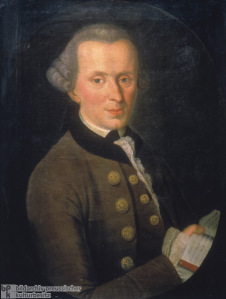Immanuel Kant
From Geography
Contents |
Life
Immanuel Kant was born in 1724 in Köningsberg (now known as Kaliningrad). From 1755 he started teaching Philosophy at the University of Köningsberg. The teaching system at the University of Köningsberg at that time was based on teachers offering courses. They were not being payed by the University, but received pay directly from their students. Kant started lecturing on the subject of physical geography in 1757.
Works
Immanuel Kant never published about the subject of Geography himself. The popularity of his lectures led to the circulation of various sets of student notes. The writings we know today are based on lectures which have been put together from these student transcripts. These were published under the name 'Physische Geographie' in 1802.
In Kant's time there were two views on space. One was a strict Newtonian way of viewing space as an entity in which objects exist both in matter and mind. The other was based on Leibniz's[2] belief that space existed only, because of a relationship between objects and/or living things. He reasoned that without distance, between objects, there could not be space. Therefore space is but a mental construct. Kant combined these spaces into a third way. In his own view space itself was a human construct. Without humans there would not be a concept called 'space'. However, he argues this is only a pattern or spatial schema. Without this, space would exist, but no one would call it space or would classify it. Concluding from Kant's viewpoint the space humans try to describe does exist. However, by describing it, we create a mental construct. It is this schematic that we call 'space'.
References
Immanuel Kant. Retrieved october 25, 2012, from http://plato.stanford.edu/entries/kant/#LifWor
Richards P. ,Kant's geography and mental maps. 1974, Retrieved october 25, 2012, from http://www.jstor.org/stable/621596
Contributors
SimonTjoonk 15:42, 25 October 2012 (CEST)
Enhanced and picture added by Kasper van de Langenberg 30/12/12
